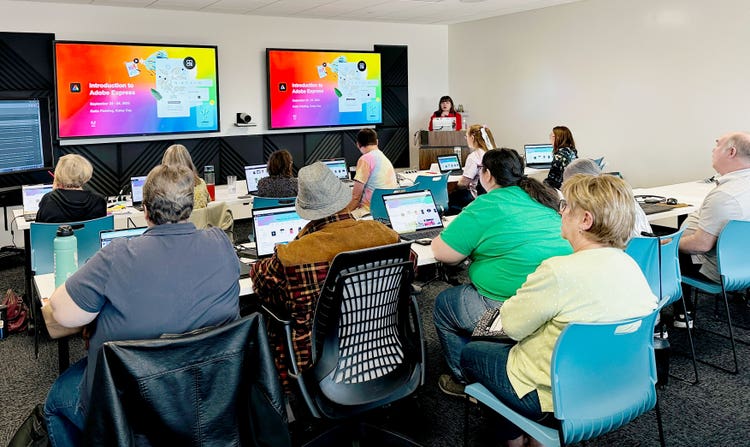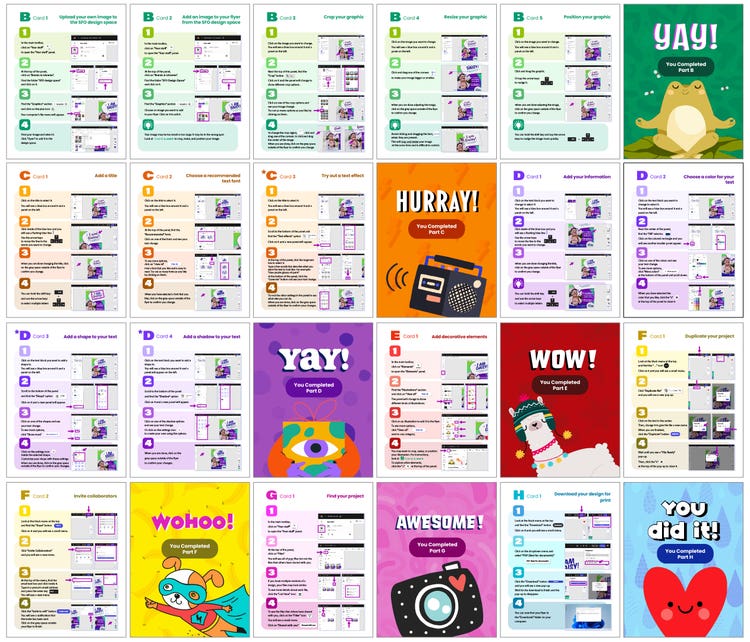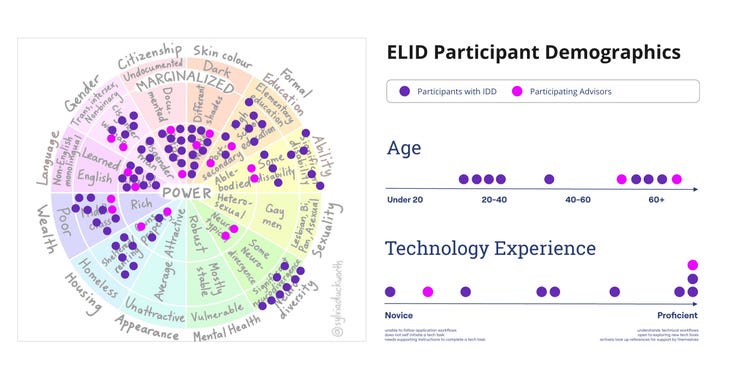Building more equitable product experiences through community co-creation
Including marginalized communities in product development is essential to increasing creative access

Illustration by Ellen Porteus
Since there isn’t enough documentation of these lived experiences intersecting with the use of modern technology, it can be tough for equity practitioners to understand the needs of marginalized social identities and serve them meaningfully. Gaining insights from those communities historically excluded from stereotypical research demographics is critical to creating equitable products and furthering product innovation. But that requires shared decision-making, mutual learning, and innovation that tries to understand and solve the challenges of marginalized communities in a way that’s beneficial to all.
The concept isn’t novel. It stems from co-design, participatory human-centered design, and other research practices that focus on product innovation with a group of people then generalizes decisions across user groups and identities. But designing based on assumptions about marginalized identities can create a product with implicit biases, which can make tools not usable, and lead to challenges. Those challenges (which can include lack of demographic clarity, difficulty in maintaining long-term partnerships, or lack of capacity to invest the required time, resources, labor, love, and patience) are lessened when communities lead the narrative and product equity teams co-plan with them.
When working with HUM communities the goal is to understand product and social challenges specific to a community’s lived experiences. That requires understanding their ecosystems, lack of power and privilege, historical context, and systemic challenges that could produce harm and bias, limit access, or result in loss of opportunity. We define this as the practice of equitable co-creation. It centers trust, reciprocity, and inclusion of HUM communities in decision making at every phase of the product design and development process. It’s essential for equity practitioners to engage with marginalized groups so they can build ecosystems and products that authentically represent these communities, removing barriers to access and allowing innovation to transcend systemic barriers of oppression. The unique and creative solutions resulting from these co-creation engagements can expand across many groups of users.
While every co-creation effort will have its own parameters and nuances, there are some universal guidelines that helped us create a framework for a recent pilot workshop focused on designing flyers in Adobe Express. We’ve broken the framework into a series of considerations that can help other teams establish meaningful partnerships and co-creation with marginalized communities.
1. Identify a community and what they want to accomplish
Identify the communities most likely to benefit from a long-term co-creation approach. Unfortunately, because HUM communities are habitually overlooked, it can make it challenging to find them or for them to proactively reach out. Some upfront questions to help identify these communities:
- Who is most likely to benefit from, but has limited or no access to your product?
- What are the limitations of research methods with the community?
- Are there anticipated hidden needs that require further observation?
- Is there a trusted relationship with the community already and how can it be nurtured?
Choose the community that most aligns with these questions. One of the success metrics of co-creation, also known as community-driven participatory design, is that it's reciprocal: Design and research teams can benefit from product insight that makes their product better for more users, while underinvested community groups might benefit from educational resources or financial access to the product or technical tools.
These mutual benefits were key in our Express Learning & Intellectual Disabilities (ELID) pilot workshop with Speaking for Ourselves (SfO), an independent self-help, self-advocacy organization run by and for people with intellectual, cognitive, and developmental disabilities.
Since IDDs (Intellectual and Developmental Disabilities) encompass a wide-range of conditions affecting memory, motor skills, problem-solving skills, attention, and comprehension—which many people could face to varying degrees during their lives—our goal was to deepen our understanding of the challenges people with IDDs face as a step toward creating more inclusive product experiences for all. SfO’s goal was to self-advocate and learn best practices for designing printable flyers that they could leverage to raise awareness for disability rights.

By setting unrealistic goals, teams can do more harm than good, so it’s important to identify the scope of engagement and potential for impact. In our case, we recognized that adults with IDDs are imaginative, creative, and artistic, but are often limited to analog tools like paper and paints due to their lack of tech access and knowledge. That limitation can prevent them from bringing their thoughts and creativity to a wider audience and using art as a form of self-expression. For SfO, Express was a great tool—it’s web-accessible, templatized, and beginner-friendly—but at the start, we weren’t sure whether it would meet their needs and provide the intuitive experience they were seeking without potential stressors. With reciprocity in mind, the collaboration with SfO gave them access to the tech and training on a new tool while giving the Product Equity team feedback to make Express neuro-cognitive and IDD access-centered.

2. Domain expertise matters: Bringing stakeholders together
For a successful co-creation session, multiple stakeholders need to come together and contribute their expertise. It's essential to consider both internal and external stakeholders for these exercises. While not everyone in your company will have experience engaging with marginalized communities, they can provide valuable domain expertise in design, project management, research, engineering, etc. To create an ecosystem where community experience and research can thrive, equity practitioners must educate stakeholders on disability and intersectional identities. It helps them apply an equitable lens to their expertise.
Include product team members in workshop design, experience, and facilitation to help them make direct observations and uncover needs from their domain expertise. Involving stakeholders in decision-making and asking them to help identify challenges that may arise during the session can reduce points of failure and increase buy-in. For example, instead of outlining details of accommodations we needed, we shared participant needs and our knowledge about IDDs with Adobe’s site facilities team, and they leveraged their existing expertise to tailor the workshop.
3. Work with your community to tailor workshops
Every workshop designed for a specific community will require unique approaches but there are considerations and best practices for making learning content accessible:
- Consult with experts who work with HUM communities to understand the community’s needs. For us, that meant meeting with special educators to discuss inclusive teaching strategies.
- Trust the community as the expert concerning their needs, accommodations, and interests. Implement modes of feedback throughout the workshop so that scope can be adjusted if it doesn't meet the community’s needs.
- Set outcome expectations for both sides. To ensure their goals were met, we worked with SfO to identify aspects of the design process they wanted to focus on.
- Employ facilitators with the right expertise. We opted for two facilitators—an expert in teaching Express, and an advisor to SfO with experience supporting members of the community.
- Plan for differences in how people receive/retain instruction and contribute to the workshop—consider communication styles and provide multiple ways for people to express their ideas.
- Eliminate known cognitive burdens from the learning experience. We reviewed existing learning materials through an IDD access lens and designed an instruction guide broken into clear steps, with visual aids, redundant numeral and color coding, a large font size, and plain language.
- Since it’s impossible to foresee how workshops will unfold, build in time for questions, sharing, self-exploration, and celebration. We created celebration moments for each learning section which provided motivation, a cognitive break, and a smooth transition to the next task.

4. Create a learning space that centers the needs of the community
Careful planning and consideration are essential to effectively activate learning mindsets, reduce participation burdens, and minimize stressors and triggers. Arrange meetings in advance with supporters or caregivers to understand necessary accommodations. Select a convenient time and location for the event and consider offering transportation services. Help ensure both physical and cognitive access by:
- Providing easy walking access and accessible building spaces
- Sharing a map marked with key locations
- Accompanying participants to ease navigation
- Posting large, readable signs
- Preloading guest information for quick check-in
- Ensuring ample space between seats for free movement
- Placing the workshop space close to water, snacks, and restrooms
- Pre-requesting all physical and technical accommodation needs
For cognitive access, reduce environmental stressors and establish clear expectations to minimize cognitive load. Consider diverse learning patterns, short attention spans, difficulty remembering complex information, and overstimulation from large groups. Create separate break rooms, offer frequent snack and meal breaks, arrange tables in groups of four to foster conversation, prepare laptops with individual files in advance, and select a well-ventilated room with ample natural light.

5. Celebrate the wins, create space for feedback, and plan for continued support
Participate, observe, support, and engage with workshop participants to understand hidden needs that interviews may not reveal. Create space for participants to share feedback, reflect on their experience, and take stock of learnings and challenges. At the end of our workshop, we held a small award ceremony to celebrate accomplishments and to discuss with participants how they felt about the experience (these also offered an opportunity to identify challenges with products and learning materials).

A successful co-creation experience is one that continues to center the community through sustainable relationships. To achieve that:
- Provide a tangible reminder of a result (for us it was a framed flyer) as a future motivator.
- Create a way for your team and the community to stay connected and engaged. This can be a messaging platform or regular virtual meetings but at minimum it should allow people to share post-workshop experiences, ask questions, and request additional learning materials.
- Understand that your product is going to change based on your research findings, so have a plan for helping people transition.
- With any follow up, make sure to include familiar faces (use the same facilitators and product experts) to not add new stressors.
Co-creation can be nuanced but with some hard-and-fast guidelines
One of the reasons this work requires patience, and a sustained commitment is so it can capture the nuance of intersectional identities over time. Equity practitioners must acknowledge and regularly identify who is included and who is missing from the co-creation process.
Although we sought to include diverse intersectional perspectives in our work, we didn’t have the chance to hear from people of color or people originating from countries outside the US. And, since it’s personal information that some may have felt uncomfortable sharing, we also chose not to ask about sexual orientation or mental health status. However, since IDDs affect cognitive and physical abilities influencing human differences, we included formal education, age, and past tech experience.

Although community-driven design and research engagements can be unique and nuanced, our experience uncovered some absolute takeaways:
Things to do
- Do bring in facilitators from the community to create a learning environment that’s supportive and founded on mutual respect.
- Do include communities in planning, not just participation. No one understands their needs better than the community themselves.
- Do talk “to” not “down” to participants and don’t be overtaken by a “savior complex.” One of the best pieces of feedback we received was that we used “plain language” that was respectful and simple but not patronizing.
- Do consider this an opportunity to get creative with research methods—don’t limit yourself to interviews and focus groups. We had the most success with show and tell, but also included observations and discussion groups (games and imaginative storytelling can also work).
- Do leave room for plans to change. We hadn’t planned for a brainstorming activity but when one happened spontaneously, we made sure our schedule was flexible enough to make space for it.
- Do work toward long-term relationship building with product access and periodic check-ins.
Things not to do
- Don’t assume that people have experience with your technology. Even basic workflows can be difficult to learn when applications are completely new to people.
- Don’t assume your teaching methods will work for everyone. We created a multimodal (three-point access) learning experience that included live demos, printed learning materials, and task-related digital slides, but it created cognitive overload for some of our group participants to put all their attention on the live facilitation.
- Don’t underestimate your group. Technology education is not a focus for folks with learning and intellectual disabilities so we were the first company to design a co-creation workshop with SfO, but our expectation was that people would be able to learn to use Express.
Co-creation takes time, so patience is key. Our Product Equity team mantra is to work at the speed of trust, and the pace of reciprocity, fueled with good health. The outcome will be an abundance of valuable information that will contribute to a world where everyone, regardless of human difference, can access and harness the power of digital products without harm, bias, or limitation.
Thank you to the members of Speaking for Ourselves, who took part in our workshop. The ideas and viewpoints you shared with us continue to motivate and shape our efforts as we work toward creating more equitable product experiences through co-creation. Thank you also to our two wonderful workshop facilitators, Kaley Day and Katie Fielding, who inspired engaging discussions and shared their expertise in inclusive learning, and to the Express Design and Learn and Adobe Design Ops teams for their support in putting on this workshop.